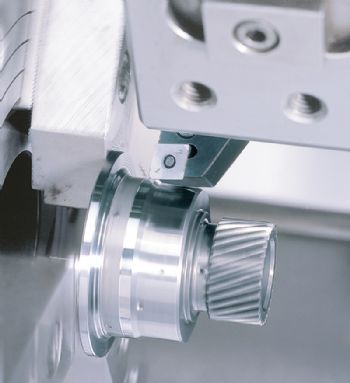
The development of a totally new high-feed-turning (HFT) solution by Sumitomo Electric Hardmetal, which has a UK subsidiary in Princes Risborough (
www.sumitomotool.com), offers higher levels of productivity when turning materials such as hardened steel (over 45HRC), thanks to its ability to accommodate higher speeds and feed rates.
The company says that, as a result, cycle times can be up to 16-times shorter than when using already-proven machining methods, while also achieving enhanced surface finishes, thanks to the use of a special wiper geometry.
Moreover, the latest CBN inserts can have up to eight cutting edges.
CBN tooling has a hardness and thermal conductivity that is second only to diamond, allowing it to be highly productive when machining heat-resistant super-alloys and grey cast irons, as well as hard ‘powdered and sintered’ metals that contain tungsten and titanium carbide.
Furthermore, CBN inserts can also be used dry, eliminating coolant and its associated disposal costs, and maintenance requirements are reduced.
The mono-block design of the HFT tool-holder features a specially developed insert location that gives fast and accurate exchange of inserts designed for turning, boring and facing; the machine interface couplings accommodate HSK, VDI, ISO-PSC and DIN shanks.
The double-clamp system for these inserts ensures a high level of insert stability, and the tool-holders provide a ‘direction-defined’ coolant/air supply.
In recent hard-turning trials, HFT inserts running at 150m/min and 1.2mm/rev achieved over 1,200 parts per insert. Previous methods/inserts used by the company in these trials not only used slower cutting speeds but also achieved only 100 parts per insert; and whereas tool life for finishing cuts was also only 100 parts per insert, HFT enabled this to be increased to 1,600 parts — and the speed to be increased from 120m/min to 150m/min.
CBN advances
The latest advances in CBN tooling combine special compounds, high-efficiency coatings and new geometries designed to withstand heat, while further improving surface finish and accommodating greater mechanical shocks — such as those generated by interrupted cutting.
For instance, Sumitomo recently introduced its ‘hybrid’ BNC2010 and BNC2020 series of hard-turning inserts featuring new chip-breaker designs, plus a new range of BSME and SEXC micro-boring bars.
These new products add to the company’s proven SumiBoron range of CBN tooling, which now covers milling and end milling cutters, as well as tools for turning, grooving, threading and boring.
Sumitomo offers various CBN insert edge preparations for hard-turning applications when using its BNC2010 and BNC2020 inserts; these allow “specific process situations and problems” to be overcome, resulting in higher levels of
stability and operational consistency.
Both the SumiBoron BNC2010 (high-precision grade) and the more-general-purpose BNC2020 feature multi-layered heat- and-wear-resistant micro-structured coatings on sintered CBN powder blanks with substrates that incorporate carbo
nitride binders.
To further improve the performance and application range of the new-grade inserts, Sumitomo has also developed a new series of ‘Break Master’ chip-breakers: N-FV and N-LV for finishing hardened steel, and N-SV for improved chip control when removing a carburised layer.
Recent trials comparing Sumitomo’s latest developments with ‘more-conventional’ coated CBN inserts when hard turning transmission shafts saw BC2010 inserts improve tool life by 230%; and when BC2020 was used for turning automotive constant-velocity joints (requiring interrupted cutting), tool life was increased by 150%.
Fine boring
Sumitomo has also applied CBN to micro-boring bars, with its BSME and SEXC series designed for holes down to 2.5mm in diameter in hardened materials — and these tools can be used for facing.
Both tool types have through-coolant, and each tool shank across the range can be held in a common 6mm-diameter sleeve using two clamp screws.
A dead-stop pin ensures repeatability when setting depths (these can be maintained to within 0.02mm).
In recent trials on sliding-head turn-mill centres, using brazed SumiBoron BSME micro-boring bars on hard material (60HRC) and neat oil coolant, tool life was increased from an inconsistent and variable 400 to 1,500 parts to a reliable 3,600 parts.
The cutting speed was 48m/min, the feed 0.2mm/rev and the depth-of-cut between 0.02 and 0.05mm.
When producing 7.1mm-diameter holes in hardened automotive components, the switch to Sumitomo’s SEXC bore bar saw the number of parts produced per insert corner increased by over 400%.
A benefit of using CBN is that the heat generated by the cutting process is despatched within the chipped material and not held in the tool or the workpiece, with the machining process tending to anneal material just ahead of the cutting zone and leaving the parent material unaffected.
A benefit of hard-turning materials above 45HRC — such as bearings, gears and toughened shafts — is the ability to eliminate grinding, hand polishing and other time-consuming and skill-dependent processes that can be difficult to control.
Moreover, finishing parts with a single process means that geometrical relationships are easier to maintain, and lead times are reduced.